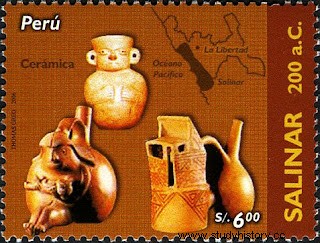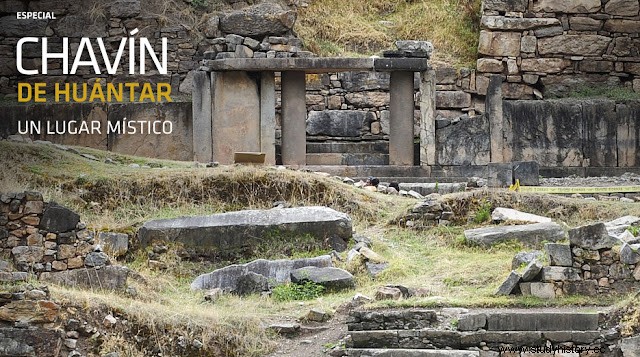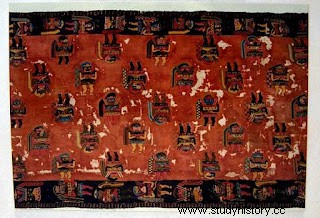ARCHAIC PERIOD (FROM 12000 TO 2000 BCE):
From the year 12000 before our era, the entire Peruvian territory was already occupied by groups of hunter-gatherers (located in the highlands of the Cordillera) and fisher-gatherers (settled on the coast), of which remains of camps and utensils (instruments and various carved stone or bone tools) already quite elaborate and specialized have been found. Little by little, human groups are growing in number and acquire the condition of sedentary, between the seventh and third millennium before our era. From the year 6000 before our era, various plant species began to be cultivated in the northern highlands (Guitarrero cave), such as beans, pumpkins and peppers. In the highlands located at levels above 4,000 meters of altitude, wild camelids such as the vicuña and the guanaco, until then hunted, become progressively controlled from the year 5000 before our era and their subsequent domestication (rocky shelter of Telarmachay) gives rise to two new species, the alpaca and the llama. On the Coast, the first ceremonial architectural ensembles were erected around 3000 BC, which implies the existence of societies already considerably structured around a solid central power and whose economy is based, approximately from 2000 before our era, on the intensive cultivation of corn and the establishment of irrigation canals in the coastal oases. Ceramics makes its appearance around 1800 before our era, without its adoption represents a profound change in the way of life. The important thing is that, between the seventh and second millennium BC, men gradually passed from a life system based on predation (hunting, fishing, gathering) to another consisting of the production of their own food (vegetables and animals). households) and from a social organization in small egalitarian groups to an infinitely more complex structure. The apogee of this economic and social progress will be characterized, at the end of the first millennium, by the emergence of the "great culture" Chavín.
OLD HORIZON (BETWEEN THE YEARS 2000 AND 100 B.C.)
THE CUPISNIQUE CULTURE (from 2000 to 400 BC)
Cupisnique is one of the regional cultures of the Costa Porte which, together with that of Kotosh, located in the highlands, will give rise to the great Chavín culture. One of its most important features was the development of ceremonial architecture. Temples are built in the shape of a "U" based on stones and adobe, whose walls present decorations of large modeled in high relief, painted, representing anthropomorphic characters with large feline fangs; There is also room for naturalistic scenes with the presence of animals (fish, felines) and even for others of greater complexity, such as the one located in the archaeological site of Cerro Sechín (war parade and scenes of massacres sculpted on stone stelae that surround a temple) .The Cupisnique economy is based on irrigated agriculture based on corn, beans, cassava and squash, which form the basis of a diet supplemented by fishing and shellfishing. The Cupisnique culture presents two characteristic forms of pottery , made up of bottles with a long conical neck and globular vessels with stirrup-shaped handles. The decoration is mainly carried out by means of deep incisions. The predominant color in the pottery elements is black, achieved through firing in a closed oven. This culture would eventually end up being influenced by the Chavín culture, quite developed at that time, as the presence of the icon of the “divinity of the staffs” indicates.
THE SALINAR CULTURE (from 400 to 100 BC)
It takes place on the north coast, where it takes over from the Cupisnique culture, then considerably influenced by the Chavín.
 The Salinar culture, whose territory was limited to the Chicama, Virú, Moche and Santa valleys, is characterized from its beginnings by making a very unique ceramic style, decorated in a very simple way with white paint on a red background. If some of its forms are reminiscent of those of Cupisnique, others represent original creations, especially those that present figurines modeled and attached to globular vessels by means of bridge-shaped handles.
The Salinar culture, whose territory was limited to the Chicama, Virú, Moche and Santa valleys, is characterized from its beginnings by making a very unique ceramic style, decorated in a very simple way with white paint on a red background. If some of its forms are reminiscent of those of Cupisnique, others represent original creations, especially those that present figurines modeled and attached to globular vessels by means of bridge-shaped handles.The Salinar culture, however, supposes the transition between the era of the great coastal temples surrounded by small villages and the beginning of urbanism proper. One of the best studied archaeological sites is Cerro Arenas (Moche Valley). It is a large stone architectural complex that includes buildings of various types, probably specialized, that reflect the existence of a well-stratified and hierarchical society. This culture is one of those that later gave rise to the Mochica culture.
CHAVÍN CULTURE (from 800 to 100 BC) The fundamental characteristics of the Chavín culture are expressed in its architecture and stone sculpture, as well as in its ceramics. One of the essential themes of a very particular iconography, made up of curved lines and scrolls, is the presence of the figure corresponding to an anthropomorphic divinity, half man, half feline, who holds a long staff in each of his hands. The diffusion of this image in a large part of Peru indicates the existence of a cultural and religious hegemony exercised from the great Temple of Chavín de Huántar, located in the northern Andean part and converted into a cultural cradle of the first magnitude that, through the process of interregional exchanges, imposes the cult of its gods and governs the agricultural calendar from the extreme north of Peru to the southern valleys. Probably, the Chavín Temple was abandoned a little before the year 100 before our era and was also Destroyed for unknown reasons. In the territories subjected until then to their influence, the cultural and religious imprint experiences a relaxation and the large population centers, coastal and mountain, are freed from the aesthetic and ideological canons of the Chavín culture, while little by little regional cultures of a very accentuated particularism.
 THE PARACAS CULTURE (2000 to 100 BC) It takes place on the southern coast of Peru, within a well-defined sector of the Ica Valley and includes two culturally well-differentiated and successive phases, called "Caverns" and "Necropolis". The oldest, “Cavernas”, was identified thanks to the contents of deep burial chambers (the “Cavernas”) cut into rocky soil. These collective tombs contained mummies wrapped in attached mantles and accompanied by offerings consisting mainly of gourds and ceramics. The “Caverns” style pottery pieces present, within equally simple forms, a polychrome decoration achieved by applying resinous pastes once the piece is fired.
THE PARACAS CULTURE (2000 to 100 BC) It takes place on the southern coast of Peru, within a well-defined sector of the Ica Valley and includes two culturally well-differentiated and successive phases, called "Caverns" and "Necropolis". The oldest, “Cavernas”, was identified thanks to the contents of deep burial chambers (the “Cavernas”) cut into rocky soil. These collective tombs contained mummies wrapped in attached mantles and accompanied by offerings consisting mainly of gourds and ceramics. The “Caverns” style pottery pieces present, within equally simple forms, a polychrome decoration achieved by applying resinous pastes once the piece is fired.  During the “Necropolis” phase, the reverse happens and the finely crafted ceramic pieces exhibit a monochrome, often in the form of fruit, while the textile art shows signs of extraordinary richness. Among the most beautiful textile pieces ever made in the world, it is worth mentioning the finely embroidered mantles decorated with fantastic polychrome anthropomorphic figures that wrapped, in superimposed layers, hundreds of mummies deposited in extensive underground chambers (the "necropolis"). Each one is squatting, inside a basket, and the whole appears wrapped in canvases constituting a thick conical bundle. During the “Necropolis” phase, the Chavín influence is clearly reflected, especially due to the presence in the iconography of the image that represents the “divinity of the staffs”. Shortly before the beginning of our era, the Paracas culture evolved without sudden changes to give birth to the Nazca culture.
During the “Necropolis” phase, the reverse happens and the finely crafted ceramic pieces exhibit a monochrome, often in the form of fruit, while the textile art shows signs of extraordinary richness. Among the most beautiful textile pieces ever made in the world, it is worth mentioning the finely embroidered mantles decorated with fantastic polychrome anthropomorphic figures that wrapped, in superimposed layers, hundreds of mummies deposited in extensive underground chambers (the "necropolis"). Each one is squatting, inside a basket, and the whole appears wrapped in canvases constituting a thick conical bundle. During the “Necropolis” phase, the Chavín influence is clearly reflected, especially due to the presence in the iconography of the image that represents the “divinity of the staffs”. Shortly before the beginning of our era, the Paracas culture evolved without sudden changes to give birth to the Nazca culture.